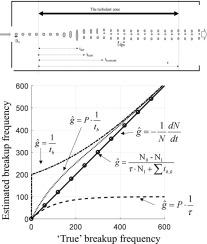当前位置:
X-MOL 学术
›
Chem. Eng. Sci.
›
论文详情
Our official English website, www.x-mol.net, welcomes your
feedback! (Note: you will need to create a separate account there.)
On the validity of different methods to estimate breakup frequency from single drop experiments
Chemical Engineering Science ( IF 4.1 ) Pub Date : 2020-12-01 , DOI: 10.1016/j.ces.2020.115908 Andreas Håkansson
Chemical Engineering Science ( IF 4.1 ) Pub Date : 2020-12-01 , DOI: 10.1016/j.ces.2020.115908 Andreas Håkansson

|
Abstract Single drop breakup visualizations are the golden standard for experimentally measuring breakup frequency, g, in turbulent flows. There is a growing demand for empirically obtained breakup frequencies, for population balance equation (PBE) based predictive modelling and for comparing to theoretical suggestions. However, five different methods to estimate g from a breakup visualization can be found in previous investigations, many of them contradictory. This study uses analytical and numerical methods to show that only two of the five suggestions result in estimates that are valid (where ‘valid’ means that the breakup frequencies are meaningful in a PBE setting). This case is also used to discuss the difference between the stochastic one drop deformation/breakup view of turbulent fragmentation and the deterministic number density based PBE description, arguing that some aspects of the breakup process will be challenging to describe within the PBE framework, regardless of the choice of breakup frequency model.
中文翻译:

从单滴实验估计破碎频率的不同方法的有效性
摘要 单滴破裂可视化是实验测量湍流中破裂频率 g 的黄金标准。对凭经验获得的分手频率、基于人口平衡方程 (PBE) 的预测建模以及与理论建议进行比较的需求不断增长。然而,在之前的研究中可以找到五种不同的方法来估计分解可视化中的 g,其中许多是相互矛盾的。本研究使用分析和数值方法来表明,五个建议中只有两个得出的估计值是有效的(其中“有效”表示分解频率在 PBE 设置中有意义)。
更新日期:2020-12-01
中文翻译:

从单滴实验估计破碎频率的不同方法的有效性
摘要 单滴破裂可视化是实验测量湍流中破裂频率 g 的黄金标准。对凭经验获得的分手频率、基于人口平衡方程 (PBE) 的预测建模以及与理论建议进行比较的需求不断增长。然而,在之前的研究中可以找到五种不同的方法来估计分解可视化中的 g,其中许多是相互矛盾的。本研究使用分析和数值方法来表明,五个建议中只有两个得出的估计值是有效的(其中“有效”表示分解频率在 PBE 设置中有意义)。











































 京公网安备 11010802027423号
京公网安备 11010802027423号